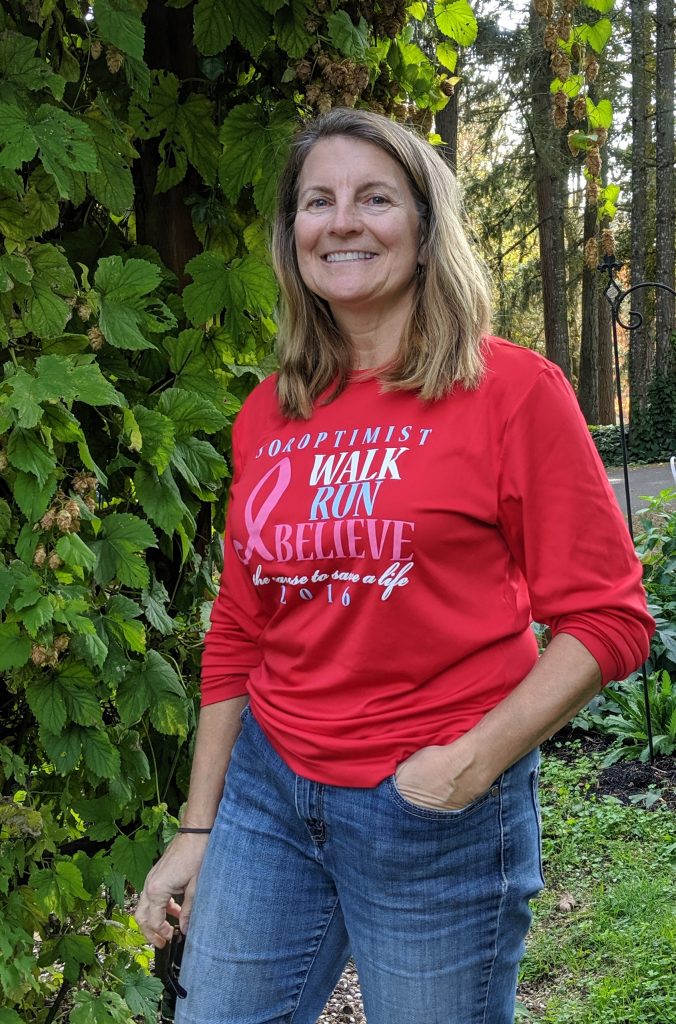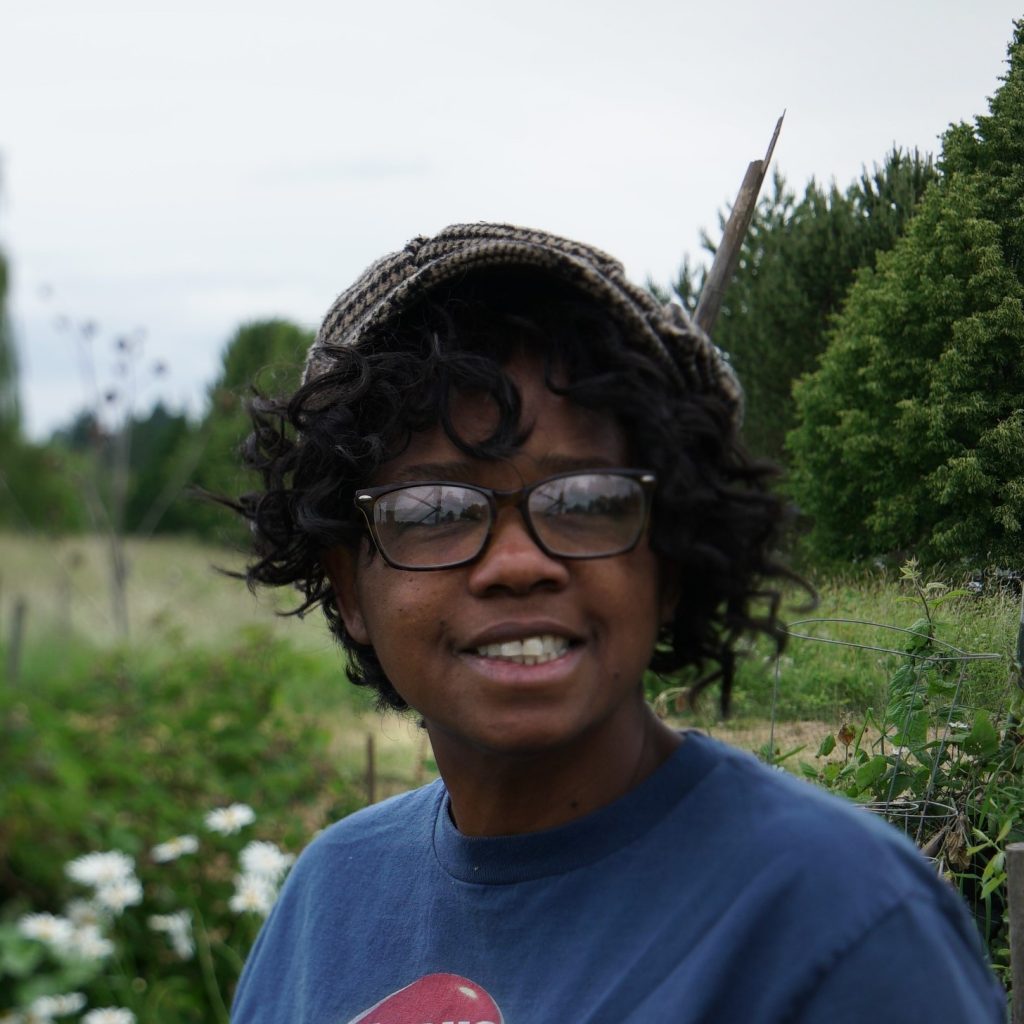
Michele Ecker became an OSU Extension Master Gardener in Linn County in 2014. She is active in supporting the Linn County Master Gardener Association’s Albany Garden Tour. Michele is always willing to lend a hand especially with children’s gardening activities. Michele shared her story in Fall 2019.
Tell us about your hometown.
My roots are in the Midwest. My family moved to Oregon from Wisconsin when I was a teenager, but I’ve lived in the Willamette Valley since I went to the University of Oregon in the early 80’s. We moved to Albany in 1984 from Klamath Falls when my husband, Lane, got a job with the Oregon Dept. of Transportation. Our daughters attended St. Mary’s School, Calapooia Middle School and South Albany High School. I think Albany is a great place to raise a family and there are certainly a lot of good things to appreciate and enjoy here. One daughter, son-in-law and two grandchildren currently live in Albany. I LOVE the long growing season in the Willamette Valley! I have a gardening friend in Wisconsin who is always envious when I send pictures from our early Spring garden.
What does being a Master Gardener volunteer mean to you?
I’ve always thought that it’s important to give some of my time for volunteering in order to connect with our community and help others. As a Master Gardener I can share my time and knowledge about gardening to encourage others and help them increase their gardening skills and knowledge. I enjoy problem solving too, so finding research-based answers for people who have gardening problems is fun for me, although I have to admit that sometimes I get frustrated on the occasions when it’s difficult to solve a problem with a definitive answer. My favorite activity is to combine children and gardening. I’ve enjoyed being involved with a school garden and the Power of Produce (PoP) program offered at the summer Farmer’s Market.
What’s a favorite garden memory?
I have had many wonderful garden experiences! One favorite includes being in the garden on an early summer morning and just absorbing the smell, sight and quiet stillness. A fresh picked, warm and ripe tomato, eaten straight from the vine is my favorite taste sensation! In the fall I love to go to the apple orchard, taste the different varieties of fruit and fill boxes to take home for making applesauce or cider with our family.
Tell us about your current garden.
We live on a plot just under one acre with lots of mature fir and oak trees, so our yard is mostly shady. Deer and other “critters” frequently visit our yard too, so there are some challenges to address. The sun is best in the front, so I grow food, flowers and herbs in an area with southern exposure. I am fortunate to have a very handy husband who constructed raised beds and plumbed water for me. In a larger area on the other side of the yard, I grow mostly flowers with some food mixed in. I have a large pot with only edibles, so the grandchildren can taste flowers and herbs, which they enjoy. Tomatoes, cucumbers (grown vertically to save space) basil and zucchini are staples in my garden. I also like to grow beets, peas, broccolini, herbs for cooking, arugula, fennel, hops and pumpkins. A bay tree has grown happily in a pot for several years. A funny “fail” I had in the garden was growing carrots. On the third try, the carrot tops had grown about an inch high and I was very excited that I was finally getting carrots to grow. I was in the garden with my grandchildren, ages 4 and 7, helping my grandson plant seeds when my granddaughter called, “Look, grandma, I pulled out the weeds!” She had pulled out the entire row of carrot greens! I enjoy growing a variety of perennial and annual flowers including foxglove, roses, dahlias, black-eyed susans, Japanese anemone, iris, clematis, nasturtium, nigella, poppies, and more. Sharing bouquets of flowers with friends and family gives me great joy.
Describe a plant that reminds you of home.
While I was growing up my family moved a few times but mom always planted rhubarb wherever we lived. My siblings and I used to love pulling out a stalk of rhubarb, dipping it in sugar and eating it. I have rhubarb in my garden today and love to use it in different ways. A family favorite is a rhubarb bread recipe from my grandma that was printed in a “heart healthy” cookbook.
What’s one thing people might be surprised to know about you and/or your garden?
Dividing dahlia tubers is a great challenge for me, even though I’ve grown them for years and I try each year, I still have to consult with my brother-in-law who is an expert at growing dahlias.
How did you begin gardening?
My gardening journey began when I was in elementary school and my family lived in rural Wisconsin on three acres. Dad decided we should have a large garden and each of us five children got to choose what we wanted to plant. I planted gourds and at the end of the season I sold them to the local grocery store and made some money. After my family moved, I don’t remember having a garden again. Eventually my family landed in Bend, Oregon, where we still grew rhubarb, but no other garden to speak of.
It was after I was married and we lived in a nondescript rental home when I wanted to plant some flowers in our yard. My husband’s grandmother bought me some stock and pansies and I wondered why they didn’t grow very well in the hard, cracked, clay soil. By this time I had three young daughters to “grow”, so I didn’t really have time for watering.
Why did you become a Master Gardener volunteer?
When our daughters were older, we planted flowers together at our own house. My youngest daughter, Alison, could walk down the fence, point to the variety of flowers and name them all at a very young age. Soon after, we removed a row of photinia and my husband made me some raised planting beds. We tried growing some vegetables and fruits, with varying degrees of success. I saw an article in the Albany Democrat-Herald about the Master Gardening class and thought it looked interesting. However, at the time, I was teaching full time and couldn’t take the classes. When I retired from teaching, the Master Gardener training was on my list of things to do. I asked a friend to join me, she said yes, and we took the training in 2014.
You can help grow knowledge, gardens and communities. Applications for the 2020 Volunteer Program are open until December 3rd. Learn more and join us.



